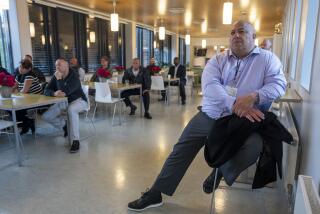South Africa’s bucolic refuge hides history of oppression
- Share via
ROBBEN ISLAND, South Africa — With thousands of penguins waddling on its beaches and rich grasslands and trees covering its interior, Robben Island seems a haven of natural serenity.
Yet, it’s the island’s legacy of cruelty that is drawing visitors.
For three decades, the small island off the coast of Cape Town was a land of beatings and humiliations, a secluded spot where the apartheid state banished and brutalized its feared opponents.
Those “pariahs” and national “bogeymen” have become some of the country’s greatest heroes with the fall of the racist apartheid state in 1994.
Before being elected president, Nelson Mandela was held here for 18 years, many in a tiny cell overlooking the prison’s dusty recreation yard. Deputy President Jacob Zuma was held here, along with apartheid fighter Walter Sisulu and “Uncle” Govan Mbeki, the revered father of President Thabo Mbeki.
“We had some brilliant minds in this jail,” says former prisoner Lionel Davis.
The prison is now a museum, a spartan monument to human cruelty and the small acts of resistance it inspired.
The museum, which opened in 1997, is still a work in progress. But it draws thousands of visitors a year, foreign tourists as well as locals.
“To this day, I think most South Africans do not know what happened to prisoners, especially prisoners on Robben Island,” Davis says.
Davis, 64, was imprisoned here from 1964 to 1971 for conspiracy to commit sabotage.
“We had this big dream of sparking a revolution,” he says. “We were very idealistic.”
Living on the island, though, was a crushing experience.
The political prisoners were allowed one visitor for half an hour every six months, had to speak in a language the warders understood and could not discuss politics or mistreatment in the prison. They could write only one letter of not more than 500 words every six months.
Some were jammed into communal cells with up to 80 people Others, such as Mandela and Davis, were kept in single cells so they would not infect the other prisoners with their revolutionary thought.
To retain their sanity amid the hard labor, the beatings and the starvation rations, the prisoners turned the island into a makeshift university. The classrooms were crowded jail cells. The notebooks were scraps of discarded cement bags. The lecturers were the lawyers and teachers locked away for their efforts to overthrow the white government.
“We became our own faculty with our own professors, our own curriculum, our own courses,” Mandela wrote in his autobiography, “Long Walk To Freedom.”
They also created soccer teams, rugby teams, and a makeshift prison Olympics with sack races and egg races.
“We had to fight to retain our dignity,” says Davis, who now works as a tour guide on the island.
Robben Island’s history of despair began more than three centuries ago, long before apartheid.
Over the years, the various rulers of nearby Cape Town -- the Dutch, the British, white South Africans -- banished what they considered their human refuse to the 1,250-acre island only four miles offshore.
Tours begin with a boat ride from Cape Town, a journey Mandela wrote “was like going to another country. Its isolation made it not simply another prison but a world of its own.”
Tourists then take a bus ride around the island.
They visit the quarries where Mandela and other political prisoners mined lime and damaged their eyes in the harsh sun that reflected off the white rock.
They tour the compound that in the 1960s held Robert Sobukwe, the leader of the Pan Africanist Congress.
Then the tour heads to the whitewashed walls of the high security prison, the museum to oppression that draws most people to the island.
More to Read
Sign up for Essential California
The most important California stories and recommendations in your inbox every morning.
You may occasionally receive promotional content from the Los Angeles Times.













